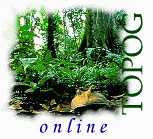
 |
|
Chapter 6 |
|
Spatial Data Display |
|
Sections 6.1 to 6.3 |
6.1 |
Introduction |
Topog_Display is a program which allows to map spatial (ie: catchment-wide) data generated by a number of Topog programs including Topog_Element, Topog_Simul, Topog_Mesh, Topog_Meshview, and Topog_Dynamic . Examples of attributes that can be mapped using Topog_Display are:
- xy data points
- contours, streamlines, roads, fences and polygons
- terrain attributes such as slope, aspect or potential solar radiation
- steady-state wetness, stream power and erosion hazard indices
- transpiration rate, water table depth and soil moisture content
- groundwater recharge and depth to aquifer
Topog_Display has been developed to provide a high degree of flexibility in data set presentation. The user can interactively change line and point colours and styles, annotate screen images with a range of font types and sizes, and zoom in on any map segment. The final composite image on the screen can then be dumped to a postscript file, which can be printed later.
However, Topog_Display is not just a data display tool. The data on the screen can be digitised and the digitised coordinates can be written to a file. The user can also interrogate spatial data sets to extract various items of catchment information such as x,y location of a wet area, elevation of a contour, or the address of an element.
Working examples of Topog_Display functions are given throughout this chapter. The following symbols are used:
signifies a user action
indicates a program response
6.2 |
Elements of Topog_Display |
When Topog_Display boots, two major windows appear as shown in Figure 6.1. We refer to these as the display window and the menu window.
An image goes in here Figure 6.1: Topog_Display's user interfaceThe display window is the working space in which all the mapped data appears. A legend appears whenever colour-shaded maps of terrain attributes or simulation results are displayed.
The menu window is divided into four main areas. The function button area contains a series of buttons which, when pressed, initiate program commands. Details of the specific functions of each button are outlined in section 6.4. The information area is used to display results of data file interrogations such as searching on contours or elements. It is also used to display colour and line/point style palettes. The selection area is primarily used to select an attribute to plot from a list of the appropriate files or items available for the particular displayed function. The response area is used to display error messages.
6.3 |
Getting started |
Most functions in Topog_Display are invoked by pointing and clicking with the mouse. Typically the user chooses an action from the menu window by pressing a function button , then selecting an option in the selection area. Occasionally the user is required to click on a graphical object in the information area or to enter typed information in the selection area.Several different cursors (or pointers) are used to indicate the mode in which the program is operating from time to time. A watch-face cursor, for instance, indicates that the program is busy executing some function, while a cross-hair cursor indicates that you are in zoom-in mode.
To run Topog_Display, type:
$ _display
When the menu window first appears, the message "enter base name" appears in the selection area. Supply the catchment base name and press Return. Ensure that the menu window is active before you start typing else nothing will appear in the selection area. If the .sys file for the supplied base name does not exist, then an error message will appear in the response area. If this occurs, check that the base name has been typed correctly and that you are in the right directory.
6.3.1
Supplying a base name
Both the display window and the menu window can be resized simply by dragging the corners of the windows (these belong to the window manager) across the screen with the mouse. The position of the windows can also be shifted by clicking the mouse on the top of the window (ie: in the banner area labelled: CSIRO Division of Water Resources) and dragging them to a new location. The position, size, style and colour of all the individual elements of the two windows can be adjusted by customising the .Xdefaults file. See Appendix D for more information on how to customise the .Xdefaults file.
6.3.2
Resizing the windows
To initiate a function in Topog_Display press any button in the function button area. All mappable data files are nested in the top six buttons in the left-hand column of the menu window; those labelled Contours, Points, Polygons, Other, Attributes and Simulation. Pressing any of these will result in a list of files appearing in the selection area. If the list is too long to fit within the selection area, the window may be scrolled by clicking the mouse on either the up or down arrow on the right-hand side of the selection area. Click the mouse on the file/item of your choice to map it in the display window. If the attribute selected does not exist for the base name supplied then an error message will appear in the response area. Once a file is displayed on the screen you can select any of the other functions like Colours, Zoom or Search. The 18 individual function buttons used in Topog_Display are described in detail in section 6.4.
6.3.3
Initiating a program function
Select the quit button to quit the program. The screen is cleared and control is returned to the system.
6.3.4
Quitting a Topog_Display session
| Take me out of frames | Chapter 6 continued....... |